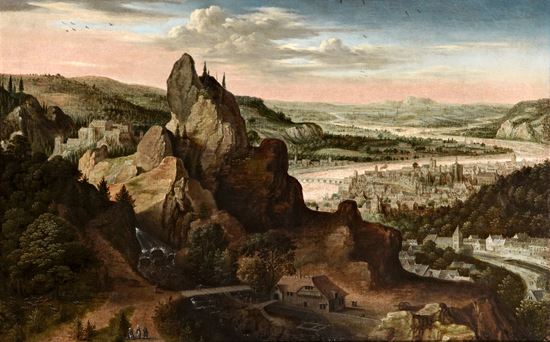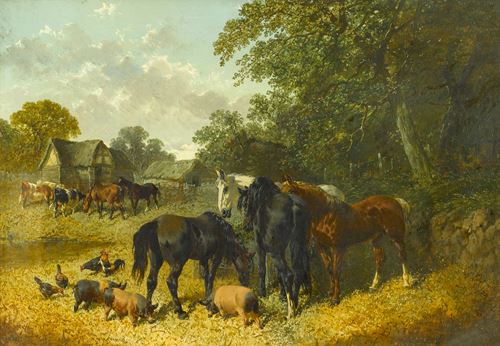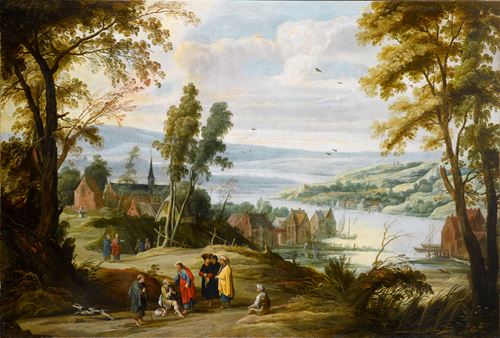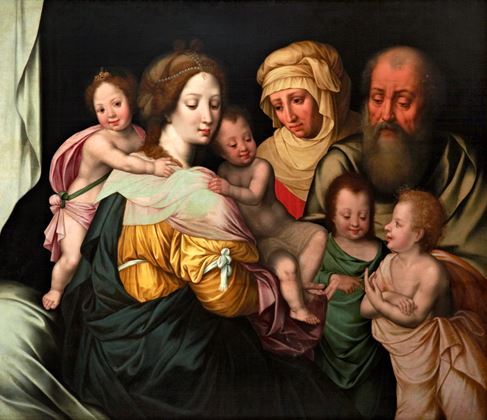ucas van Valckenborch
(Leuven c.1530 - Frankfurt am Main 1597)
A Panoramic Mountain Landscape, with a City, possibly Frankfurt, beyond
oil on canvas
53.5 x 81 cm (21 x 31⅞ in)
This panoramic scene is typical of Lucas van Valckenborch’s mountainous landscape paintings. The left-hand side of the work is dominated by a bare crag, projecting into the sky. In its shadow lies a dense forest, a fiercely flowing river, and a mill. Beyond this precipitous foreground is vast river valley containing a large sprawling city.
This painting is actually a larger version of a work in the Liechtenstein Princely Collections. Our work is painted on canvas, whereas the Liechtenstein version is on panel, although this change of support is not unusual for van Valckenborch, who also frequently used copper. The Liechtenstein version is dated 1595, towards the end of van Valckenborch’s career, and it therefore seems likely that ours is a similarly mature work.
In a discussion of the Liechtenstein version, Walter Liedtke suggests that the city nestling in the river valley is probably based on Frankfurt.¹ Van Valckenborch certainly included faithful topographical depictions of other cities, such as Linz or Antwerp, in his work, and the Liechtenstein painting dates from his Frankfurt period. As Liedtke points out, ‘the long bridge that crossed the city’s wall between the town of Sachsenhausen and Frankfurt met the city’s walls at a square tower like the one seen here’.² Liedtke also points to the fact that many of the many details, such as the round and square towers, or the scale and style of the Cathedral, recall contemporary depictions of Frankfurt. However, Liedtke also points to significant differences between sixteenth-century Frankfurt, and the city that is depicted in both ours and the Liechtenstein paintings. Therefore it seems that van Valckenborch, rather than attempting to paint a topographically accurate depiction of Frankfurt, has used Frankfurt as his inspiration. This free approach to topographical accuracy is a typical feature of van Valckenborch’s landscapes.
The composition of our painting, with dramatic promontory on the left-hand side leading the eye to a valley beyond, is the same basic template which van Valckenborch used in mountain landscapes throughout his career. Alexander Wied has pointed to the consistency with van Valckenborch used this technique over the years.³ For example paintings such as those in the Rijksmuseum in Amsterdam, or the Kunsthistorisches Museum in Vienna, were painted over ten years before our work, and there are other even earlier examples.⁴ This repeated composition is one reason why undated landscapes, such as our painting, are hard to place within the van Valckenborch’s ouevre.
The present work is part of a tradition in Flemish sixteenth-century painting, known as ‘world landscapes’, a term used to describe panoramic vistas taken from a bird’s eye viewpoint.⁵ Leading figures of this genre, apart from van Valckenborch, were Joachim Patinir (c. 1480 - 1524), Herri Met de Bles (c. 1510 – after 1550), Pieter Brueghel the Elder (c. 1525 – 1569) and Hans Bol (1534-1593). Several of Bol’s works, which were widely disseminated through engravings, relate closely to van Valckenborch’s landscapes, particularly in the compositional arrangements (fig. 4). Liedtke also suggests that van Valckenborch would have seen, and been inspired by Brueghel’s alpine drawings, when both artists were working in Mechelen.⁶ Our painting is a typical example of this type of landscape, which aimed to convey a panoramic and awe-inspiring vision of nature, whilst simultaneously providing small precise details of everyday sixteenth-century life, exemplified in our painting by features such as the mill or the flock of sheep.
Van Valckenborch came from a Flemish family of artists, of whom at least fourteen were painters, the most notable, aside from himself, being his brother, Marten van Valckenborch I (1534-1612), and his nephews Frederik van Valckenborch (1566-1623) and Gillis van Valckenborch (1570-1622). Although he was born in Leuven, in 1560 Lucas is recorded as joining the Painter’s Guild in Mechelen and here he took on pupils, married and had a son, Marten van Valckenborch II (before 1566-1597), who also became a painter.
In Mechelen, Lucas established his reputation, but in 1566, like many of his contemporaries, was forced to leave to avoid religious persecution after the Spanish occupied the southern Netherlands. Initially Lucas moved to Liège, then onto Aachen and Antwerp. In 1579 he became the court painter to the Habsburg Archduke Matthias (1557-1619), who was governor of the Spanish Netherlands in Brussels and in 1612 would become Holy Roman Emperor. Van Valckenborch’s official duties included designing costumes for Matthais’ guard, and painting his portraits. In 1593 he left to enter into the service of Matthais’ brother Archduke Ernst (1553-1595) in Frankfurt. Much of his family had already settled there, and the influence of the van Valckenborchs on the artistic development of Frankfurt was significant.
According to the biographer Karel van Mander (1548-1606), it wasn’t van Valckenborch’s landscapes that attracted the patronage of Archduke Matthias, but his skill as a portraitist. He became a renowned court portraitist, painting at least six of the Archduke, and was proficient at working in both life-size and miniature. His skill as a miniaturist is evidenced by the figures that occur in his landscapes.
However, Van Valckenborch’s most notable achievements were undoubtedly his landscapes. As discussed, in terms of composition he was very much a traditionalist, with his panoramic scenes depicted from a high viewpoint. However, he did base these works on a first-hand observation of nature to a much greater extent than some his predecessors, as reflected in his loose depiction of Frankfurt in our painting. His palette is also more sophisticated than many other sixteenth-century landscape painters, as it is rarely schematic and mannered, rather he sensitively blends browns, blues and greens. Our painting is a late, but typical, example of his work.
We are grateful for Dr. Alexander Wied for confirming the attribution of the present work to Lucas van Valckenborch.
¹ Liedtke, W., in Liechtenstein: The Princely Collections, exh. cat., Metropolitan Museum of Art, New York, October 1986 – May 1986, p.282.
² Ibid.
³ Wied, A., Lucas und Marten van Valckenborch: Das Gesamtwerk Mit Kritischem Oeuvrekatalog (Luca Verlag, Freren, 1990), p.28.
⁴ The earliest example is dated 1570, see Wied, p. 137, no. 12.
⁵ For an extensive discussion of this term see Gibson, W. S., “Mirror of the Earth”: The World Landscape in Sixteenth-Century Flemish Painting (Princeton: Princeton University Press, 1989).
⁶ Liedtke, p. 292.
This panoramic scene is typical of Lucas van Valckenborch’s mountainous landscape paintings. The left-hand side of the work is dominated by a bare crag, projecting into the sky. In its shadow lies a dense forest, a fiercely flowing river, and a mill. Beyond this precipitous foreground is vast river valley containing a large sprawling city.
This painting is actually a larger version of a work in the Liechtenstein Princely Collections. Our work is painted on canvas, whereas the Liechtenstein version is on panel, although this change of support is not unusual for van Valckenborch, who also frequently used copper. The Liechtenstein version is dated 1595, towards the end of van Valckenborch’s career, and it therefore seems likely that ours is a similarly mature work.
In a discussion of the Liechtenstein version, Walter Liedtke suggests that the city nestling in the river valley is probably based on Frankfurt.¹ Van Valckenborch certainly included faithful topographical depictions of other cities, such as Linz or Antwerp, in his work, and the Liechtenstein painting dates from his Frankfurt period. As Liedtke points out, ‘the long bridge that crossed the city’s wall between the town of Sachsenhausen and Frankfurt met the city’s walls at a square tower like the one seen here’.² Liedtke also points to the fact that many of the many details, such as the round and square towers, or the scale and style of the Cathedral, recall contemporary depictions of Frankfurt. However, Liedtke also points to significant differences between sixteenth-century Frankfurt, and the city that is depicted in both ours and the Liechtenstein paintings. Therefore it seems that van Valckenborch, rather than attempting to paint a topographically accurate depiction of Frankfurt, has used Frankfurt as his inspiration. This free approach to topographical accuracy is a typical feature of van Valckenborch’s landscapes.
The composition of our painting, with dramatic promontory on the left-hand side leading the eye to a valley beyond, is the same basic template which van Valckenborch used in mountain landscapes throughout his career. Alexander Wied has pointed to the consistency with van Valckenborch used this technique over the years.³ For example paintings such as those in the Rijksmuseum in Amsterdam, or the Kunsthistorisches Museum in Vienna, were painted over ten years before our work, and there are other even earlier examples.⁴ This repeated composition is one reason why undated landscapes, such as our painting, are hard to place within the van Valckenborch’s ouevre.
The present work is part of a tradition in Flemish sixteenth-century painting, known as ‘world landscapes’, a term used to describe panoramic vistas taken from a bird’s eye viewpoint.⁵ Leading figures of this genre, apart from van Valckenborch, were Joachim Patinir (c. 1480 - 1524), Herri Met de Bles (c. 1510 – after 1550), Pieter Brueghel the Elder (c. 1525 – 1569) and Hans Bol (1534-1593). Several of Bol’s works, which were widely disseminated through engravings, relate closely to van Valckenborch’s landscapes, particularly in the compositional arrangements (fig. 4). Liedtke also suggests that van Valckenborch would have seen, and been inspired by Brueghel’s alpine drawings, when both artists were working in Mechelen.⁶ Our painting is a typical example of this type of landscape, which aimed to convey a panoramic and awe-inspiring vision of nature, whilst simultaneously providing small precise details of everyday sixteenth-century life, exemplified in our painting by features such as the mill or the flock of sheep.
Van Valckenborch came from a Flemish family of artists, of whom at least fourteen were painters, the most notable, aside from himself, being his brother, Marten van Valckenborch I (1534-1612), and his nephews Frederik van Valckenborch (1566-1623) and Gillis van Valckenborch (1570-1622). Although he was born in Leuven, in 1560 Lucas is recorded as joining the Painter’s Guild in Mechelen and here he took on pupils, married and had a son, Marten van Valckenborch II (before 1566-1597), who also became a painter.
In Mechelen, Lucas established his reputation, but in 1566, like many of his contemporaries, was forced to leave to avoid religious persecution after the Spanish occupied the southern Netherlands. Initially Lucas moved to Liège, then onto Aachen and Antwerp. In 1579 he became the court painter to the Habsburg Archduke Matthias (1557-1619), who was governor of the Spanish Netherlands in Brussels and in 1612 would become Holy Roman Emperor. Van Valckenborch’s official duties included designing costumes for Matthais’ guard, and painting his portraits. In 1593 he left to enter into the service of Matthais’ brother Archduke Ernst (1553-1595) in Frankfurt. Much of his family had already settled there, and the influence of the van Valckenborchs on the artistic development of Frankfurt was significant.
According to the biographer Karel van Mander (1548-1606), it wasn’t van Valckenborch’s landscapes that attracted the patronage of Archduke Matthias, but his skill as a portraitist. He became a renowned court portraitist, painting at least six of the Archduke, and was proficient at working in both life-size and miniature. His skill as a miniaturist is evidenced by the figures that occur in his landscapes.
However, Van Valckenborch’s most notable achievements were undoubtedly his landscapes. As discussed, in terms of composition he was very much a traditionalist, with his panoramic scenes depicted from a high viewpoint. However, he did base these works on a first-hand observation of nature to a much greater extent than some his predecessors, as reflected in his loose depiction of Frankfurt in our painting. His palette is also more sophisticated than many other sixteenth-century landscape painters, as it is rarely schematic and mannered, rather he sensitively blends browns, blues and greens. Our painting is a late, but typical, example of his work.
We are grateful for Dr. Alexander Wied for confirming the attribution of the present work to Lucas van Valckenborch.
¹ Liedtke, W., in Liechtenstein: The Princely Collections, exh. cat., Metropolitan Museum of Art, New York, October 1986 – May 1986, p.282.
² Ibid.
³ Wied, A., Lucas und Marten van Valckenborch: Das Gesamtwerk Mit Kritischem Oeuvrekatalog (Luca Verlag, Freren, 1990), p.28.
⁴ The earliest example is dated 1570, see Wied, p. 137, no. 12.
⁵ For an extensive discussion of this term see Gibson, W. S., “Mirror of the Earth”: The World Landscape in Sixteenth-Century Flemish Painting (Princeton: Princeton University Press, 1989).
⁶ Liedtke, p. 292.




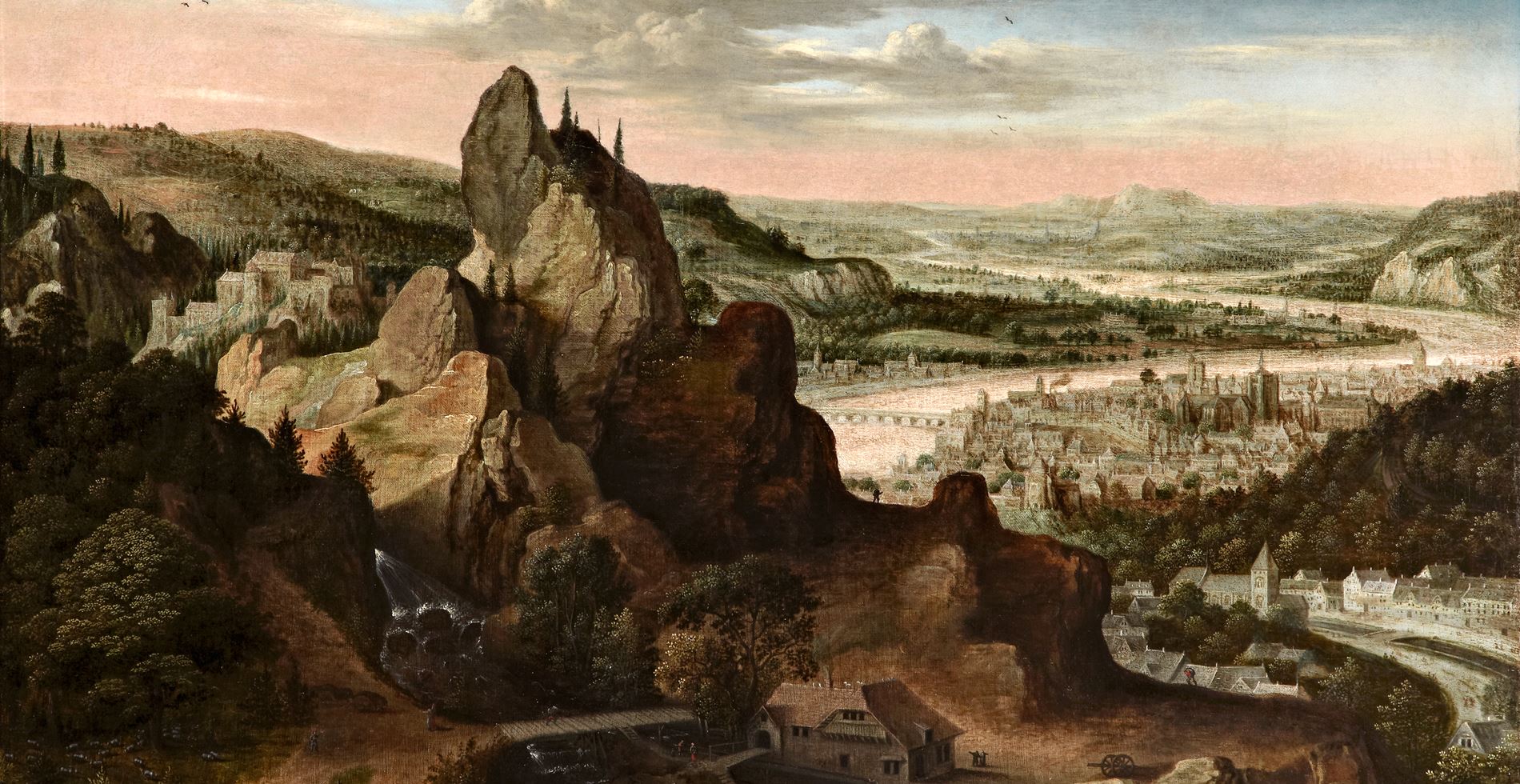
 contact
contact +44 20 7313 8040
+44 20 7313 8040


